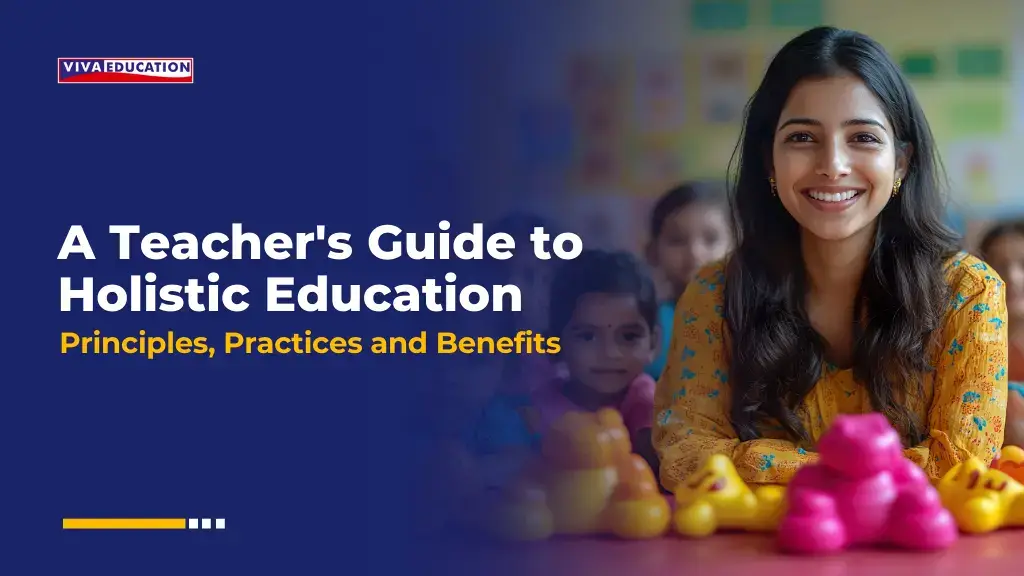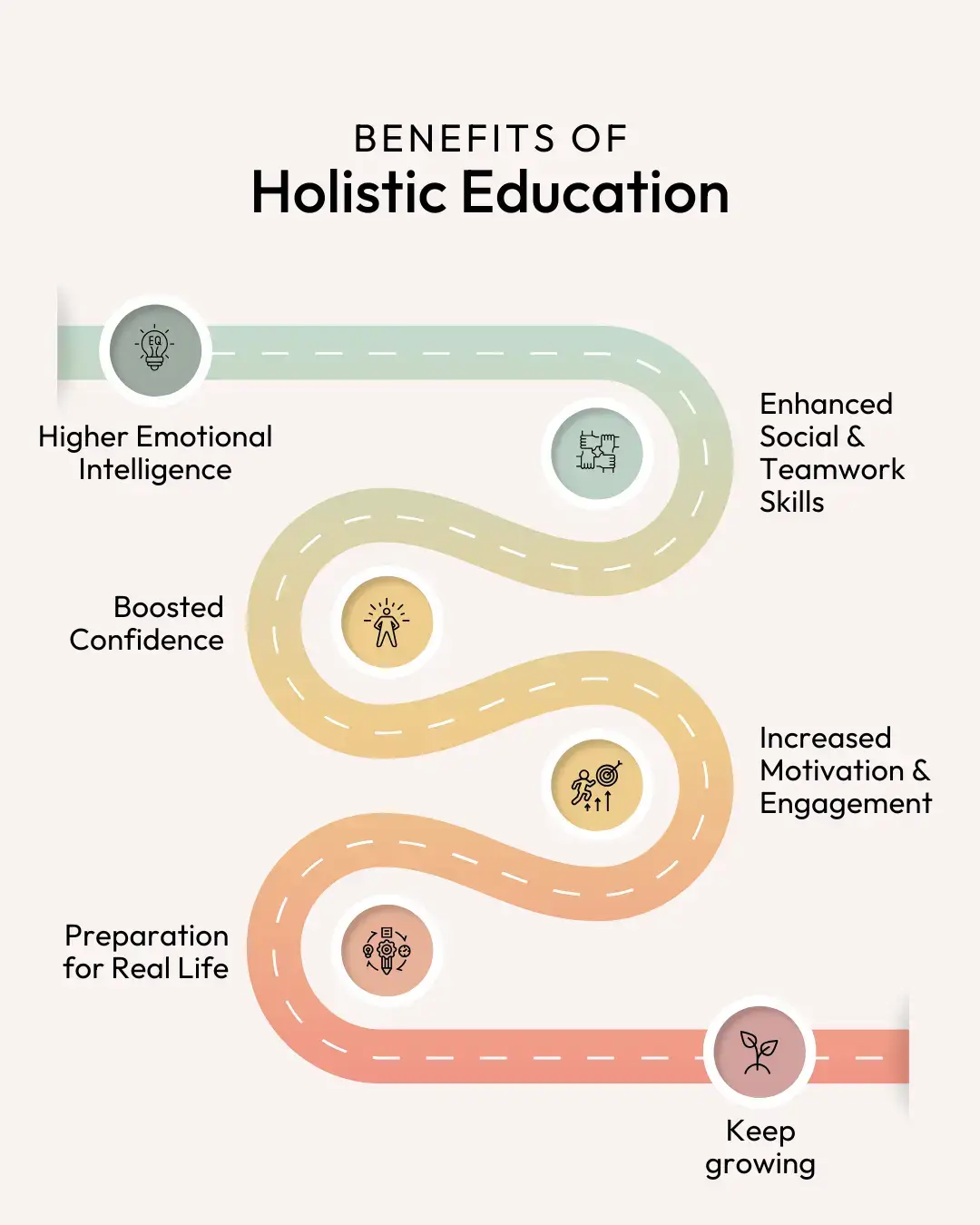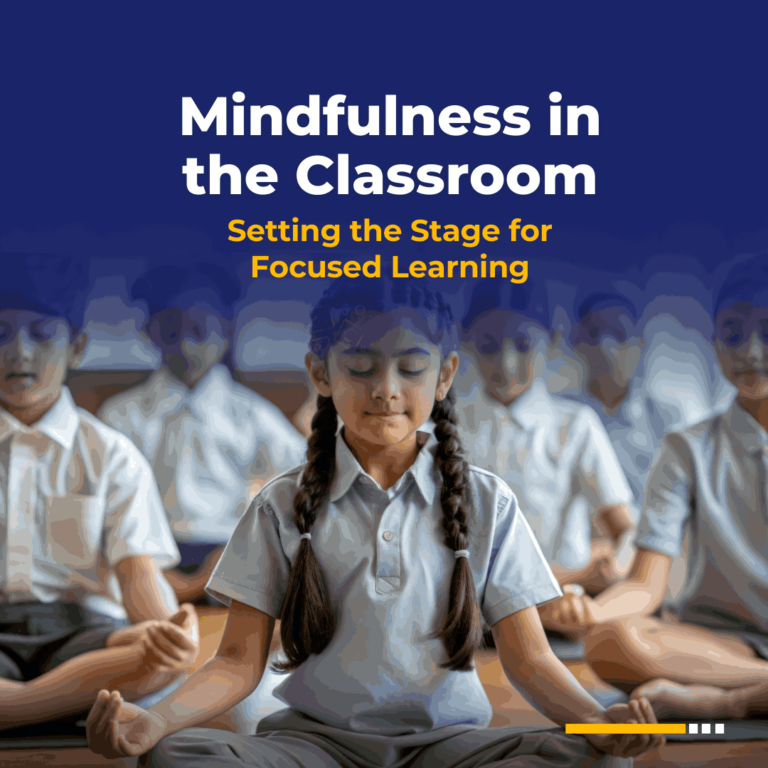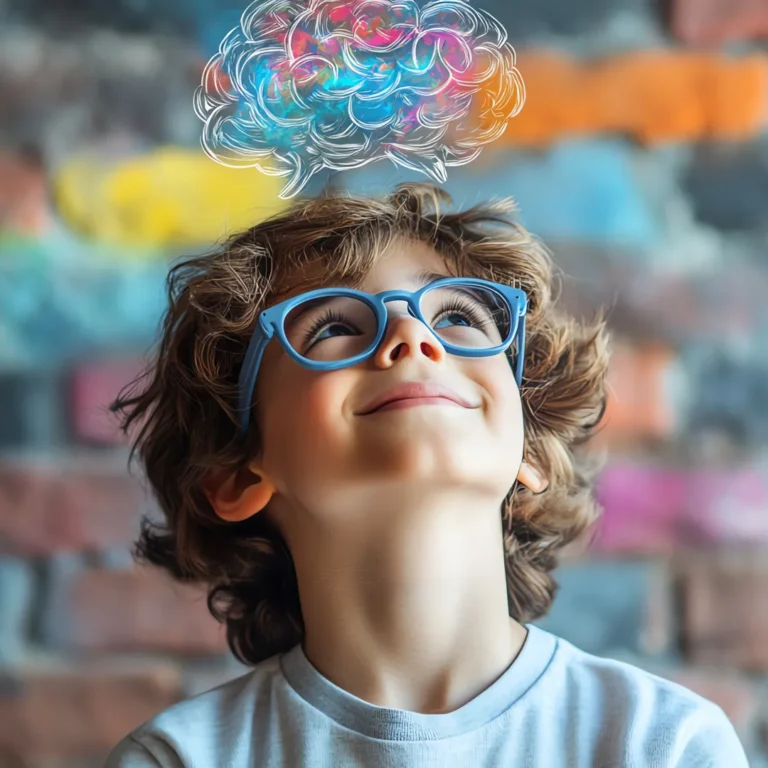A Teacher's Guide to Holistic Education: Principles, Practices and Benefits
- Teachers
- November 15, 2024
- Viva Education

You walk into your classroom, greeted by the familiar hum of students sharing stories and laughter from the weekend. As you move through the room, you ask Myrah about her soccer game, watching her face light up as she shares her excitement. Across the room, you compliment Samyak’s art project, noticing how he relaxes and realising his work matters. These small moments remind you that teaching is about creating a space where each student feels seen and valued.
A study in BMC Public Health found that students with strong support networks are more motivated and satisfied—two critical factors for academic success. The National Education Policy (NEP) 2020 and the National Curriculum Framework (NCF) 2023 finally acknowledge what teachers have known: real education nurtures the whole student.
This guide will show practical ways to create a supportive, holistic classroom that helps students feel connected, engaged, and ready to learn. Ready to dive in? Let’s get started!
What is Holistic Education?
Holistic education nurtures students as whole individuals, focusing on their emotional, social, physical, and ethical growth alongside academics.
Rather than prioritizing memorization and tests, it makes learning relevant by connecting it to real life, sparking curiosity, and giving students purpose. Inspired by Jan Christian Smuts’ 1926 concept of “holism,” which sees the world as an interconnected whole, this approach encourages students to see connections across subjects and apply their learning to the bigger picture.
Rooted in ancient philosophy, indigenous wisdom, and experiential learning, holistic education values hands-on activities and self-directed exploration. It helps students become compassionate, well-rounded individuals ready to engage with the world.
Holistic Learning Priorities:
- Building connections across different subjects
- Encourage creativity and self-expression
- Emphasizing emotional, physical, and social well-being
- Making learning meaningful and purposeful
The Core Principles of Holistic Education
Here are the essential principles that make holistic education effective:
- Emotional and Social Growth
Holistic learning values students’ emotional well-being, promoting environments where they feel safe and respected. According to Maslow’s Hierarchy of Needs, when basic needs like security and belonging are met, students are more open to learning. - Interdisciplinary Learning
Instead of teaching isolated subjects, holistic education creates connections. For example, science, history, and art can be woven together, helping students see the relevance of each subject in a broader context. - Creativity and Individual Expression
Every student has unique interests and ways of learning. Encouraging students to express themselves through various forms, like art, storytelling, and music, honours their individuality and boosts engagement. - Physical and Mindful Practices
Movement and mindfulness help students manage stress and improve focus. Incorporating yoga, meditation, or physical activities enhances students’ self-awareness and emotional regulation. - Purpose-Driven Learning
When students see the “why” behind their learning, they become more motivated. Holistic Learning encourages meaningful lessons that inspire curiosity and lifelong learning.
Source: Wikipedia
Benefits of Holistic Education
Adopting a holistic learning approach brings numerous benefits that extend beyond the classroom:

- Higher Emotional Intelligence (EI): Research shows that individuals with high emotional intelligence often achieve more than those with high IQs alone. Holistic learning helps students build EI, aiding emotional resilience, empathy, and social skills.
- Enhanced Social and Teamwork Skills: Group activities and community projects teach collaboration and empathy, which are essential for developing positive social skills and strong community ties.
- Boosted Confidence and Self-Agency: Holistic learning encourages self-confidence and a sense of agency in students’ learning journeys by focusing on their strengths and talents.
- Increased Motivation and Engagement: When learning feels relevant and purposeful, students are likelier to stay engaged and motivated in school and beyond.
- Preparation for Real Life: Holistic learning prepares students to be thoughtful, compassionate, and active community members. Rather than focusing solely on grades, it equips them with the skills to face life’s challenges with resilience and creativity.
Holistic Education Strategies for Your Classroom
Integrating holistic education doesn’t require an overhaul of your teaching style. Here are some practical strategies to get started:
- Mindfulness and Emotional Reflection
Begin each day with a few minutes of mindfulness, like breathing exercises or reflection. For example, ask students to journal or discuss their feelings, which promotes emotional awareness and empathy. - Project-Based Learning with Real-Life Applications
Holistic education thrives on project-based and experiential learning. Create interdisciplinary projects that connect subjects. For example, a science project on ecosystems can be linked with art (drawing habitats) or language (writing stories about environmental themes). - Community-Based Learning
Engage students in community service or local projects to help them feel part of a larger world. Activities like neighbourhood clean-ups or volunteering at community centres show students that learning isn’t just for personal gain but also for the betterment of society. - Self-Guided Learning
Empower students to explore topics of interest at their own pace. Self-guided projects allow them to discover how they learn best, which builds confidence. - Integrate Arts and Movement
Including the arts and physical activities enhances cognitive development and stress relief. To encourage a balanced approach to learning, try setting aside time for creative activities or physical movements, such as 15 minutes of yoga or a quick nature walk. - Use Interactive and Digital Resources
Utilize resources encouraging active participation and reflection to make holistic education engaging and accessible. Viva Education offers a range of in-text activities and digital resources designed around a holistic learning approach. These resources promote critical thinking, creativity, and self-expression, seamlessly integrating into your lesson plans and reinforcing the principles of holistic education. - Social and Emotional Learning (SEL) Integration
Integrate SEL by regularly including empathy, resilience, and teamwork activities. Group discussions, collaborative projects, and empathy exercises help students develop social skills, build self-awareness, and form positive connections with classmates. - Goal-Setting and Reflection
Help students set personal, academic, and social goals. Encourage them to reflect regularly on their progress and celebrate their achievements. This practice of reflection builds self-awareness and responsibility, making learning feel more personal and purposeful.
The Teacher’s Role in Holistic Education

Holistic education encourages you to see your role as an educator. Instead of being the “sage on the stage,” you become a guide, creating a space where students feel supported, engaged, and inspired to explore, ask questions, and make connections. Here’s how that might look in your classroom:
- Building Emotional Safety and Support
Build a strong relationship with each student, focusing on creating a supportive environment. At-risk students, in particular, benefit from a safe, nurturing atmosphere where they feel understood and respected. - Modelling Empathy and Emotional Intelligence
Demonstrate empathy, resilience, and conflict resolution. Students who see these skills in action are more likely to develop them. - Encouraging Self-Confidence
Self-confidence is crucial for holistic learning. Let students explore topics they’re passionate about and praise their unique strengths. Students gain confidence in their abilities when they see that their talents and perspectives are valued. - Facilitating Reflection and Mindfulness
Introduce daily reflections or short mindfulness sessions. Encourage students to journal their thoughts or express emotions creatively, which helps them understand and manage their feelings.
Embracing the Holistic Approach in Education
Holistic learning is about creating compassionate, curious, and well-rounded individuals who understand their place in the world. As teachers, we hold the incredible power to help students grow as learners and human beings. With mindfulness practices, real-world projects, and community learning, we can transform education into a significant experience.
With holistic education, we’re planting seeds for a better future. So, let’s roll up our sleeves, embrace these practices, and see the incredible difference they make!



